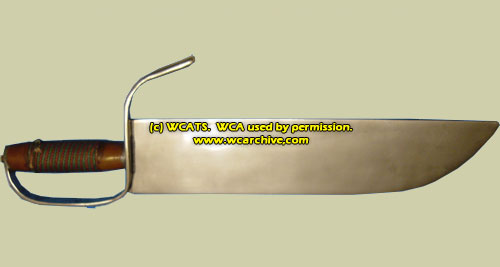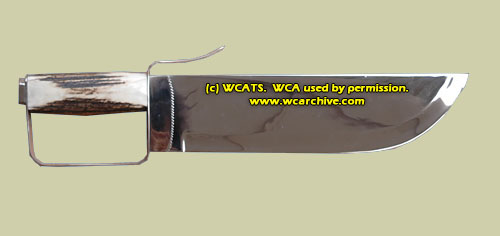|
About Wing Chun Bat Jum Dao
(Eight Slashing/Piercing Sword-Set)
by Danny Yinsheng Xuan
Sword Terminology
Wing Chun uses two types of
weapons in its system. One is called the Luk Dim Boon Goon, or the Six and a Half Pole-Set
in English. The other
weapon is the Bat Jum Dao, or the Eight Slashing Sword-Set, in English. Although
a misnomer, the swords are often referred to as Butterfly or Broad Swords in
English.
The pole length is between 9 to 12 feet, depending on the
user's stature. The swords' length also varies, depending on the user's arm
length.
About the Name of the Swords
Among the Chinese Wing Chun community, the Wing Chun swords
are never referred to as butterfly swords or broadswords. The reference may have
come from Western spectators or reporters who did not know the name of the
swords or form. They may have referenced it with other twin sword styles that
propel their light blades like butterfly wings; or may have coined it in close
proximity with butterfly hand knives. To my knowledge, Wing Chun's Bat Jum Dao
was never referred to as butterfly swords in Chinese, and has only become
associated with them in the English language.
As for the Bat Jum Dao being referred to as broadswords, it is
once again an English misnomer. In Chinese, the broadsword is a long sword,
whose blade is narrow at the guard, but broadens widely at the belly front.
Translated, Bat Jum Dao literally means "Eight Cutting
Swords." However, in Chinese verbiage it means more than that. Bat (sometimes
spelled Bot, Baat, Bart or Bard) clearly means Eight. Jum (sometimes spelled
Jaam, Jarm, Cham, Charm, Chaam, or Chum) refers to any knife or sword wielding
action such as cutting, slashing, chopping, thrusting, stabbing, and etc. Dao,
(sometimes spelled Do or Dou) in this case refers to swordplay, swordset, or
sword form. Therefore, I've translated Bat Jum Dao as Eight Slashing/Piercing
Sword-Set.
About the Types of Bat Jum Dao
Chinese swordsmen often wielded two swords. However, twin
short swords, or long daggers were uncommon. They were more prominent in
southern China, where close-range fighting was more practical and popular. Hung
Gar style, another southern fighting style, also uses a pair of short-swords,
which the stylists call Mother-and-Son swords. Since the usage is quite
different from Wing Chun's style, the swords are shaped and balanced
differently. Most of the short twin swords sold online and in the market are
either Mother-and-Son swords, or fake ones claiming to be either Wing Chun or
Hung Gar swords.
There are two or three types of Wing Chun Bat Jum Daos. I say
two OR three because one is really obsolete and non-applicable for the
Wing Chun system.
Because of the transitions Wing Chun went through in different
generations, different shape swords were used by different practitioners. (Read
Sifu Benny Meng's article on BJDs at
http://home.vtmuseum.org/articles/meng/butterflyknives.php.)
Pre-Wing Chun Era Swords
The first type, which I consider obsolete and non-applicable
for Wing Chun, was used in the early days before the development of Wing Chun,
or pre-Wing-Chun days. Remember that the roots of all Chinese martial arts came
from the monasteries. The monks experimented and used many types of weapons,
particularly household and farm tools. The first twin short-swords were probably
kitchen or farm knives, which the monks used to defend themselves. They probably
made some changes to them to avoid killing the bandits or invaders they
encountered. They used them to disarm, disable or maim them; but not to kill
them. Since the intend was not to kill, they probably used them for slashing
arms and legs instead of stabbing or chopping bodies; therefore, the blades were
most likely semi-sharp or sharp at the belly only; the tip was not sharply
pointed; and the handle was not aligned to the tip of the blade.
This is the type commonly and erroneously sold and used by the
shops and Wing Chun practitioners these days.
 |
This design was probably used by the monks in what I
refer to as Pre-Wing Chun era. It really does not reflect the principles
and concept of Wing Chun. As you can see, the point of the sword is not
aligned with the handle (as shown by the gray arrow). With such a
design, one would NOT have full control of either stabbing, chopping or
slicing. It is plainly a poor design; probably designed by a blacksmith
who didn't know much about fighting or butchery. Unfortunately, this is
the type of swords general sold in the market today as Wing Chun Bat Jum
Dao, or Butterfly Swords. |
|
 |
Red Boat Era Swords
Bat Jum Dao really came into being in the era of the Red Boat
Traveling Opera team or the Righteous Red Flower insurgents, where the swords
merged into the Wing Chun system for real battles against the Manchurian
soldiers. Because of Wing Chun's aggressive forward (versus lateral and
retreating) movements, the blades were shaped like daggers (the handles were
aligned to the blade tips) to facilitate stabbing. However, unlike a true
dagger, where the blade is shaped symmetrically on both sides (back and edge),
the BJD blades were asymmetrical. The back of the blade sloped to the blade tip,
but the sharp-edge side followed a straighter path and bellied up to the tip.
Thus, the wider blade spine weighed the blade down to facilitate chopping
action, and the belly shape facilitated slashing action. The complete design
balanced the swords for practical stabbing, chopping and slashing actions for
Wing Chun practitioners.
 |
This BJD design was used in the Chinese Insurgents
versus Manchurians era. The point of the blade is aligned to the center
of handle (as shown by the gray arrow). This design is particularly
effective for thrusting but lends to chopping and slashing as well. This
design is rarely known or seen in today's Wing Chun community. It is a
lethal weapon, and dangerous to use for daily practice. |
|
 |
Modern Era Swords
After the warring years, when firearms became more prominent,
Wing Chun became more of a self-defense art for individual than for "martial"
purposes. Practitioners spent more time training and learning, as we now do
today, than using it in the streets. Consequently, sharp, pointed, and lethal
swords were not necessary anymore. In fact, the dagger-shaped BJDs were
dangerous and accident prone. Thus, the BJDs were reshaped for training rather
than warring. This was probably in the era of Leung Jan or Yip Man. The swords
reverted to a flat and straight back; the handle was aligned with the blade back
and point. The edge was almost parallel to the back line, but took on a slight
incline to about 3 inches from the blade point, where it bellied up. The swords
became either blunt or semi-sharp. The shape change took away some (not all) of
the stabbing functions, and stress more towards chopping and slicing. On the
other hand, the dagger-shape blade, even if the edge was blunt, would cause
sever damage if thrusted into a body, since the blade point is so acute. By
rounding the blade point, the depth of its entry into a body is limited.
 |
This Bat Jum Dao design is seen and used by many Wing
Chun sifus. The blade point is aligned to the edge of the handle, to
facilitate chopping, slashing and some stabbing movements. The blades
are usually unsharpened to avoid accidental cutting or stabbing. |
|
 |
Last Thoughts
Although the modern BJD blade shape reverted to almost the
Shaolin days, the new BJD had some significant differences. First of all, the
handle is aligned with the blade back and point. This gives the user more
control over chopping, slicing, and even stabbing. The force from the user's
hand, in this case, is directly in line with the blade point for thrusting. The
hand is also above the blade (no blade above it), to give weight to the bottom,
to give force to chopping action. The slight incline of the edge towards the
blade, and the bellying in the front, facilitates slicing action.
Both BJDs, warring and peaceful era, were capable of
thrusting, chopping and slicing; however, the functional priorities were
different. The functional priorities determined the design; i.e. the alignment
of the handle with the blade, the shape of the blade, and the specifications of
the guards. The dagger-shape BJDs in the warring era leaned more towards
stabbing, followed by chopping, and then slicing. On the other hand, the
flat-back curve-front blade shape in the peaceful era leaned more towards
slicing, followed by chopping, then stabbing. These two designs, I would say,
are true Bat Jum Dao designs. The other designs do not fit the specs of BJD or
the concept of Wing Chun.
It is a shame that Bat Jum Daos in the market are so ugly.
They look like meat cleavers or wood choppers. There is absolutely no pride in
the making of these swords. Bat Jum Dao is a symbol of achievement. It is the
graduation trophy for a Wing Chun student. Many Wing Chun schools use the Bat
Jum Dao as their icon in their certificates and logos. So, shouldn't you own the
best pair of Bat Jum Daos to symbolize your achievement and respect for this
magnificent ancient art? WCATS produces top quality, authentic Wing Chun Bat Jum
Daos.
Copyright (c) 2005 the Wing Chun Archive and
Danny Xuan 10/26/05 |
